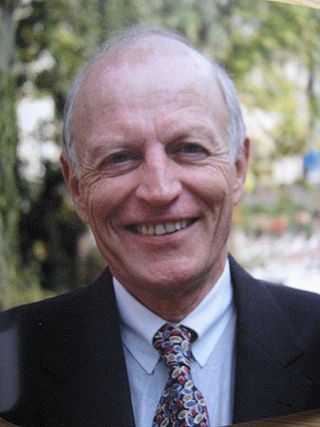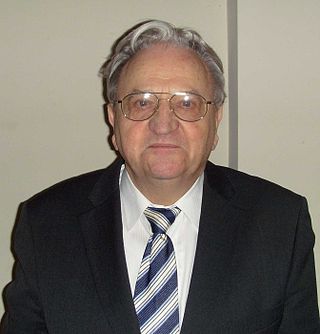Related Research Articles

Friedrich Wilhelm Reinhold Pieck was a German communist politician who served as the chairman of the Socialist Unity Party from 1946 to 1950 and as president of the German Democratic Republic from 1949 to 1960.

Oskar Brüsewitz was an East German Lutheran pastor who committed public self-immolation on August 18, 1976, to protest the repression of religion in the Communist state of East Germany. He died four days later.

Max Seydewitz was a German politician. Between 1947 and 1952 he was the Minister-President of Saxony in the German Democratic Republic.

The Stiftung Ettersberg is legally established foundation, located in Weimar, Germany. Its mission is the comparative study of European dictatorships and their transition to democracy. The foundation administers the Memorial and Education Centre Andreasstrasse, a museum housed in the former Stasi prison in Erfurt.

Dieter Mahncke is a scholar of foreign policy and security studies, and Alfried Krupp von Bohlen und Halbach Professor Emeritus of European Foreign Policy and Security Studies at the College of Europe. He is the author of books and articles on European security, arms control, German foreign policy, Berlin, US-European relations and South Africa.

Zersetzung was a psychological warfare technique used by the Ministry for State Security (Stasi) to repress political opponents in East Germany during the 1970s and 1980s. Zersetzung served to combat alleged and actual dissidents through covert means, using secret methods of abusive control and psychological manipulation to prevent anti-government activities. People were commonly targeted on a pre-emptive and preventative basis, to limit or stop politically incorrect activities that they may have gone on to perform, and not on the basis of crimes they had actually committed. Zersetzung methods were designed to break down, undermine, and paralyze people behind "a facade of social normality" in a form of "silent repression".

Helmut Müller-Enbergs is a German political scientist who has written extensively on the Stasi and related aspects of the German Democratic Republic's history.
Hubert Egemann was a German politician. He served the central committee of East Germany's ruling (SED as the Head of two related departments covering Traffic and networks and Transport and Communications.

Thomas Ammer is a German historian who as a young man studied to become a physician. He was arrested and imprisoned in 1958 for anti-government political activism in East Germany and he never qualified as a medical doctor. His 15-year prison sentence was cut short in August 1964 when his release was purchased by the West German government, and at the age of 27 he relocated to the German Federal Republic.
Bruno Brunowitsch Mahlow was a German politician and an East German diplomat.
Hermann Weber was a German historian and political scientist. He has been described as "the man who knew everything about the German Democratic Republic".

Ernst Schmutzer was a German theoretical physicist.
Horst Bartel was a German historian and university professor. He was involved in most of the core historiography projects undertaken in the German Democratic Republic (1949–1989). His work on the nineteenth-century German Labour movement places him firmly in the mainstream tradition of Marxist–Leninist historical interpretation.
Ehrhart Neubert is a retired German Evangelical minister and theologian.
Christa Schmidt is a retired German politician (CDU). She served as a minister in the last government of East Germany. She had built an earlier career as a teacher and educationalist.
Lina Maria Becker was a German Communist Party politician. Between 1924 and 1927 she was a member of the Hamburg Parliament .
Lydia Poser was a German politician of the KPD and SED and widow of the executed Communist official Magnus Poser.

Elli Paula Schmidt was a German communist political activist with links to Moscow, where as a young woman she spent most of the war years. She returned in 1945 to what later became the German Democratic Republic where she pursued a successful political career till her fall from grace: that came as part of a wider clear out of comrades critical of the national leadership in the aftermath of the 1953 uprising. She was formally rehabilitated on 29 July 1956, but never returned to mainstream politics.

The Memorial and Education Centre Andreasstraße, is a museum in Erfurt, Germany, which is housed in a former prison used by the East German Ministry for State Security (Stasi). It is informally known as the Stasi Museum.

Hermann Matern was a German communist politician (KPD) and high ranking functionary of the Socialist Unity Party of Germany and statesman in the German Democratic Republic.
References
- 1 2 3 Martin-Michael Passauer; Christian-Erdmann Schott (compiler) (2008). Weggemeinschaft mit Peter Maser. pp. 7–14. ISBN 978-3-8258-1265-2.
{{cite book}}:|work=ignored (help) - 1 2 3 4 "Apl. Prof. A.D. Dr. Theol. Peter Maser ... Kurzvita". Evangelisch - Theologische Fakultät, Münster. Retrieved 18 April 2017.
- 1 2 3 4 5 6 "Prof. Dr. Peter Maser, Vorsitzender". Fachbeirat Wissenschaft. Bundesstiftung zur Aufarbeitung der SED-Diktatur, Berlin. Retrieved 18 April 2017.
- 1 2 3 Hans Brückl (16 January 2002). ""Die Kraft der Schwachen" - Der Weg der Kirchen in der DDR" (PDF). Vortrag von Prof. Dr. Peter Maser in der Berliner Gedenkbibliothek zu Ehren der Opfer des Stalinismus. Gedenkbibliothek zu Ehren der Opfer des Kommunismus e.V., Berlin (Nikolaiviertel). Retrieved 18 April 2017.
- ↑ "Geleitwort des Vorsitzenden". Die Pforte: Schulpfotra-Nachrichten. 2010. p. 4. Retrieved 18 April 2017.
- 1 2 3 4 5 6 Constanze Matthes (compiler) (8 April 2014). "Porträt: Der renommierte Kirchenhistoriker Peter Maser gehört dem wissenschaftlichen Beirat zur Lutherdekade an". Gemeinsame Redaktion der mitteldeutschen Kirchenzeitungen, Weimar. Retrieved 18 April 2017.
- ↑ Malwine Maser; Christian-Erdmann Schott (2008). Veroeffentlichungsliste Prof Dr Peter Maser. pp. 297–309. ISBN 978-3-8258-1265-2.
{{cite book}}:|work=ignored (help) - ↑ Helga Heilig (4 August 2009). "Vom Ruhestand ist nicht die Rede". Zeitungsverlag Naumburg Nebra GmbH & Co. KG. Retrieved 18 April 2017.
- ↑ Peter Maser (1996). Auf dem Weg zur deutschen Einheit: Anmerkungen zur neuen Enquete-Kommission des Deutschen Bundestages - Aufgabe und Ergebnisse der ersten Enquete-Kommission zur SED-Diktatur (PDF). p. 69. ISBN 3-931-575-17-9 . Retrieved 18 April 2017.
{{cite book}}:|work=ignored (help) - ↑ "Schlußbericht der Enquete-Kommission "Überwindung der Folgen der SED-Diktatur im Prozeß der deutschen Einheit"" (PDF). Sachverständige: .... Prof. Dr. Peter Maser, Westfälische Wilhelms-Universität Münster, Evangelisch-Theologische Fakultät, Ostkirchen-Institut. Bundesrat, Berlin. 10 June 1998. Retrieved 18 April 2017.
- ↑ "Wissenschaftlicher Beirat". Stiftung Ettersberg, Weimar. Retrieved 18 April 2017.
- ↑ Stefan Rhein (2016). Gegen, Neben und Miteinander (PDF). pp. 15–16. ISBN 978-3-934868-40-3 . Retrieved 18 April 2017.
{{cite book}}:|work=ignored (help)